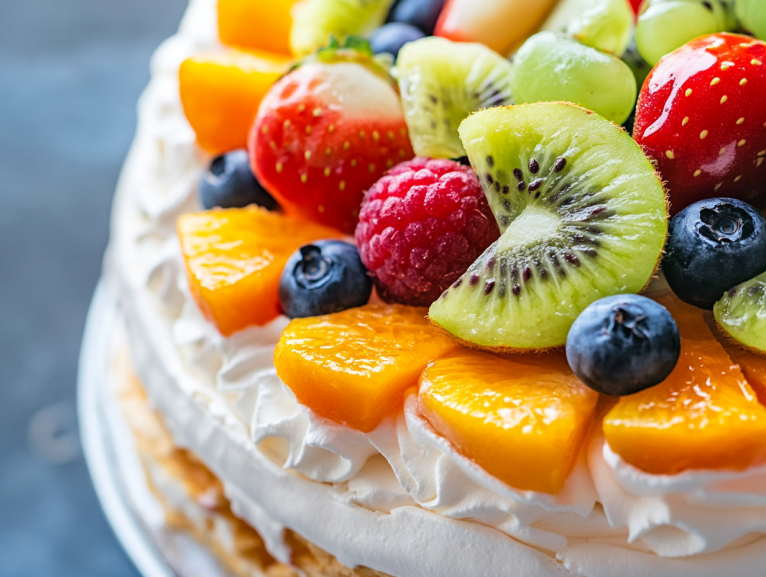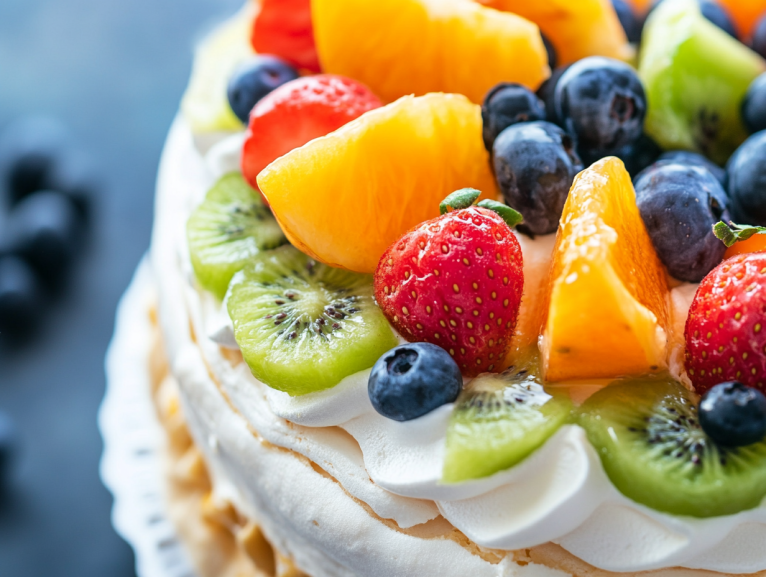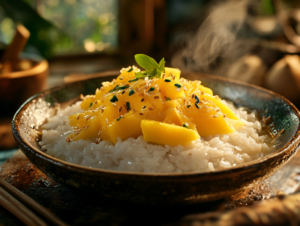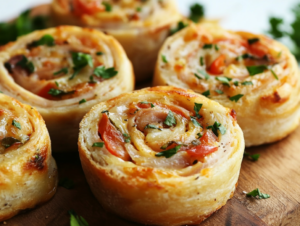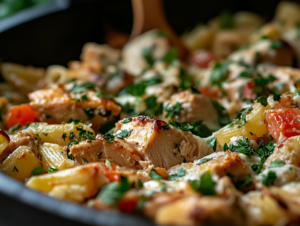Pavlova is a delicate meringue-based dessert that boasts a crisp exterior and a soft, marshmallow-like interior. Often adorned with whipped cream and fresh fruits, it’s a favorite at gatherings and celebrations. Named after the Russian ballerina Anna Pavlova, this dessert is believed to have been created in her honor during her tours to Australia and New Zealand in the 1920s. Both countries claim its origin, but regardless of its true birthplace, pavlova has become a beloved treat worldwide.
Ingredients
For the meringue base:
- 4 large egg whites, at room temperature
- 1 cup (200g) granulated sugar
- 1 teaspoon white vinegar or lemon juice
- 1 teaspoon vanilla extract
- 2 teaspoons cornstarch
For the topping:
- 1 cup (240ml) heavy whipping cream
- 2 tablespoons powdered sugar
- 1 teaspoon vanilla extract
- Fresh fruits of your choice (e.g., strawberries, kiwi, passion fruit, berries)
Directions
- Preheat the Oven: Preheat your oven to 300°F (150°C). Line a baking sheet with parchment paper and draw a 7-inch (18 cm) circle as a guide. Flip the parchment paper over so the pencil or pen mark doesn’t transfer to the meringue.
- Prepare the Meringue:
- In a clean, dry mixing bowl, beat the egg whites on medium speed until soft peaks form.
- Gradually add the granulated sugar, one tablespoon at a time, beating well after each addition. Continue until the meringue is glossy and stiff peaks form.
- Gently fold in the vinegar (or lemon juice), vanilla extract, and cornstarch until just combined.
- Shape the Meringue:
- Spoon the meringue onto the prepared parchment paper, using the drawn circle as a guide.
- Shape it into a nest with a slight depression in the center to hold the toppings later.
- Bake:
- Place the baking sheet in the preheated oven. Immediately reduce the oven temperature to 250°F (120°C).
- Bake for 1 hour and 15 minutes. The meringue should be crisp and dry on the outside.
- Turn off the oven, leave the door slightly ajar, and let the meringue cool completely inside. This gradual cooling helps prevent cracks.
- Prepare the Whipped Cream:
- In a mixing bowl, whip the heavy cream with the powdered sugar and vanilla extract until soft peaks form. Be cautious not to overbeat.
- Assemble the Pavlova:
- Once the meringue is completely cool, transfer it to a serving plate.
- Gently spread the whipped cream over the center of the meringue.
- Arrange the fresh fruits on top of the whipped cream as desired.
- Serve:
- Slice the pavlova with a sharp knife and serve immediately.
Nutritional Information (per serving, based on 8 servings):
- Calories: Approximately 200
- Protein: 3g
- Fat: 10g
- Carbohydrates: 25g
- Sugar: 24g
- Fiber: 1g
Servings: 8
Prep Time: 20 minutes
Cooking Time: 1 hour 15 minutes (plus cooling time)
Tips for a Perfect Pavlova
Making pavlova requires precision, and a few key techniques can help you achieve the best results. First, always ensure your egg whites are at room temperature before whipping them. This allows for better volume and a more stable meringue. Additionally, use a clean, dry mixing bowl, as even a small trace of grease can prevent the egg whites from whipping properly. When adding sugar, do so gradually, one tablespoon at a time, to ensure it dissolves completely. This prevents a grainy texture and helps the meringue stay smooth and glossy. During baking, avoid opening the oven door, as sudden temperature changes can cause the meringue to crack. Humidity can also impact the texture, making it sticky or weepy, so it’s best to make pavlova on a dry day. Once baked, pavlova is best enjoyed immediately after assembling. However, if needed, store the unassembled meringue in an airtight container at room temperature for up to two days to maintain its crispness.
Variations
Pavlova is incredibly versatile, and you can easily customize it with different flavors and toppings. For a chocolate twist, gently fold sifted cocoa powder into the meringue before baking to create a rich, chocolaty variation. If you prefer a tropical flair, top the pavlova with mango, pineapple, and passion fruit for a refreshing and exotic dessert. You can also make mini pavlovas by creating smaller individual meringue nests instead of one large base. This not only makes serving easier but also allows you to experiment with different toppings. When making mini pavlovas, be sure to adjust the baking time, as smaller portions will bake faster than a full-sized pavlova.
The Secret to a Perfectly Crispy Yet Soft Pavlova
One of the most fascinating aspects of pavlova is its unique texture—crispy on the outside while remaining soft and marshmallow-like inside. Achieving this balance requires careful handling of ingredients and precise baking techniques. The slow baking process at a low temperature allows the outer shell to dry out while keeping the center pillowy. However, overbaking can turn the interior dry and crumbly instead of soft. To avoid this, always follow the recommended baking time and allow the pavlova to cool gradually in the oven with the door slightly open. This ensures that the structure stabilizes without developing excessive cracks.
Choosing the Right Fruits for Pavlova
The choice of fruit toppings plays a crucial role in enhancing the pavlova’s flavor. Since the meringue and whipped cream provide a rich sweetness, it’s best to balance it with fruits that have a tart or slightly acidic note. Classic options like strawberries, raspberries, and passion fruit offer a refreshing contrast, while kiwis add a tangy twist. For a tropical variation, try mango, pineapple, or pomegranate seeds. You can also drizzle a bit of lemon or lime juice over the fruit to further enhance the bright, zesty flavors, making every bite more vibrant and well-rounded.
Serving Pavlova for Special Occasions
Pavlova is not just a dessert—it’s a showstopper at any gathering. Whether you’re celebrating a birthday, hosting a holiday dinner, or preparing a romantic dessert, pavlova’s airy elegance makes it the perfect centerpiece. You can even customize it for different themes by adjusting the toppings. For Christmas, decorate it with red and green fruits like cranberries and kiwi. On Valentine’s Day, add chocolate shavings and raspberries for a decadent touch. If serving at a summer party, a mix of tropical fruits and a passion fruit drizzle will make it feel light and refreshing.
How to Store Leftover Pavlova
Since pavlova is best enjoyed fresh, leftovers can be tricky to store. The meringue tends to absorb moisture quickly, making it lose its crisp texture. If you have an unassembled pavlova base, store it in an airtight container at room temperature for up to two days. Once assembled with whipped cream and fruit, it’s best to consume it within a few hours. If you need to refrigerate leftovers, keep them in an uncovered container to minimize moisture absorption, though the texture may soften. For an alternative, repurpose leftover pavlova by layering it with yogurt and fruit to create a delicious, creamy parfait.
Frequently Asked Questions
Q: Can I make pavlova ahead of time?
A: Yes, you can bake the meringue base a day in advance and store it in an airtight container. Assemble with cream and fruits just before serving to maintain its crispness.
Q: My meringue cracked. What did I do wrong?
A: Cracking can occur due to rapid temperature changes. Ensure the meringue cools slowly in the oven with the door slightly ajar after baking.
Q: Can I use different types of sugar?
A: Superfine (caster) sugar is ideal as it dissolves more easily, resulting in a smoother meringue. If unavailable, you can pulse granulated sugar in a food processor to achieve a finer texture.
Final Thoughts
Pavlova is an elegant, light, and utterly delicious dessert that is perfect for any occasion. Whether you stick with the classic version or get creative with flavors, this treat is sure to impress. Try it today and enjoy a slice of this heavenly delight!
Print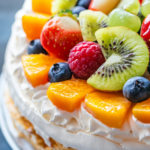
Pavlova Recipe: A Light and Elegant Dessert
Ingredients
For the meringue base:
- 4 large egg whites, at room temperature
- 1 cup (200g) granulated sugar
- 1 teaspoon white vinegar or lemon juice
- 1 teaspoon vanilla extract
- 2 teaspoons cornstarch
For the topping:
- 1 cup (240ml) heavy whipping cream
- 2 tablespoons powdered sugar
- 1 teaspoon vanilla extract
- Fresh fruits of your choice (e.g., strawberries, kiwi, passion fruit, berries)
Instructions
- Preheat the Oven: Preheat your oven to 300°F (150°C). Line a baking sheet with parchment paper and draw a 7-inch (18 cm) circle as a guide. Flip the parchment paper over so the pencil or pen mark doesn’t transfer to the meringue.
- Prepare the Meringue:
- In a clean, dry mixing bowl, beat the egg whites on medium speed until soft peaks form.
- Gradually add the granulated sugar, one tablespoon at a time, beating well after each addition. Continue until the meringue is glossy and stiff peaks form.
- Gently fold in the vinegar (or lemon juice), vanilla extract, and cornstarch until just combined.
- Shape the Meringue:
- Spoon the meringue onto the prepared parchment paper, using the drawn circle as a guide.
- Shape it into a nest with a slight depression in the center to hold the toppings later.
- Bake:
- Place the baking sheet in the preheated oven. Immediately reduce the oven temperature to 250°F (120°C).
- Bake for 1 hour and 15 minutes. The meringue should be crisp and dry on the outside.
- Turn off the oven, leave the door slightly ajar, and let the meringue cool completely inside. This gradual cooling helps prevent cracks.
- Prepare the Whipped Cream:
- In a mixing bowl, whip the heavy cream with the powdered sugar and vanilla extract until soft peaks form. Be cautious not to overbeat.
- Assemble the Pavlova:
- Once the meringue is completely cool, transfer it to a serving plate.
- Gently spread the whipped cream over the center of the meringue.
- Arrange the fresh fruits on top of the whipped cream as desired.
- Serve:
- Slice the pavlova with a sharp knife and serve immediately.

